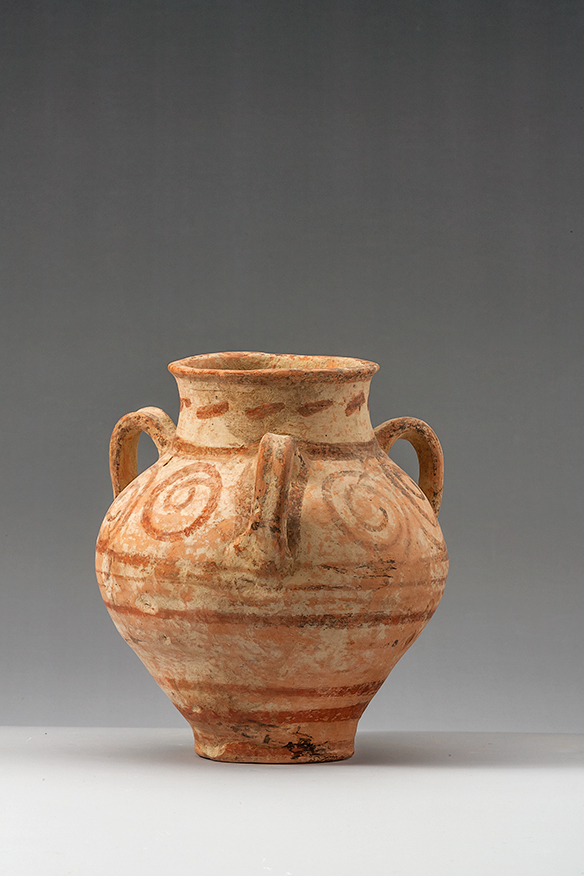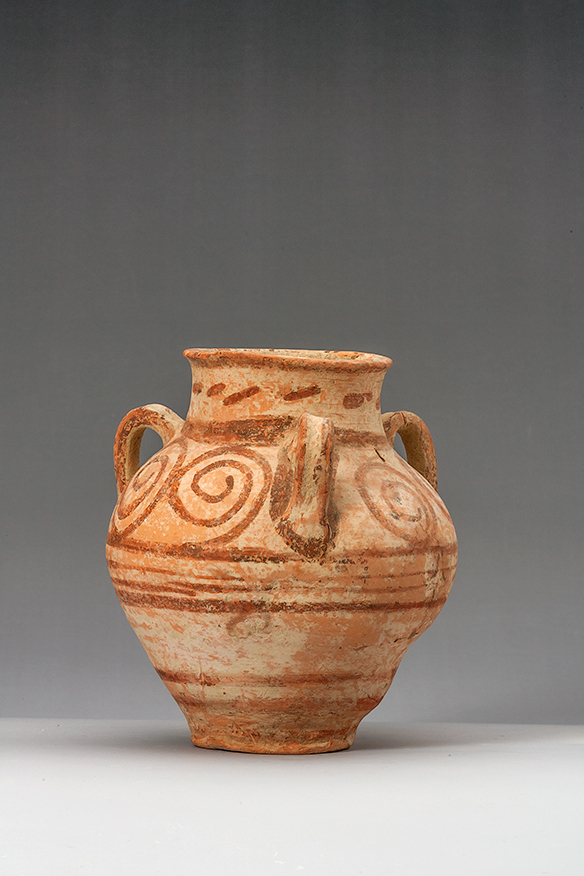Acquisition number: 1976.03
Minoan Piriform Jar. Intact and in good condition. Smooth pinkish buff clay; mid- to dark-brown paint. Poorly made with uneven rim and irregularities in the body, especially the lower wall. Simple rim, slightly everted; flat, cut-away base with clear traces of the stringmarks; three handles of slightly concave section.
Title: Minoan Piriform Jar - 1976.03
Acquisition number: 1976.03
Acquisition source or name: Charles Ede Ltd, London
Acquisition year: 1976
Owner type: ANU Classics Museum
Price: $458.00
Author or editor: J.R. Green
Culture or period: Late Minoan III C
Date: 12th - 11th century BC
Date century or Timeline (notional): 1200 to 1001
Material: Clay - Terracotta
Object type: Vessels - Jar
Technique or style: Piriform
Dimensions: 155mm (w) × 174mm (h)
Origin region or location: Greece
Origin city: Crete
Display case or on loan: 1
Collection history: Purchase
Keywords: Bronze Age, Late Minoan III C, Minoan
Charles Ede Ltd (London), Antiquities 103 (June 1976) no. 30 (ill.); J.R. Green with B. Rawson, Catalogue of Antiquities in the Australian National University, A.N.U., Canberra, 1981, 18.
1976.03
Minoan Piriform Jar
Purchased. Max. ht 17.4cm; diam. 15.5cm.
Intact and in good condition. Smooth pinkish buff clay; mid- to dark-brown paint. Poorly made with uneven rim and irregularities in the body, especially the lower wall. Simple rim, slightly everted; flat, cut-away base with clear traces of the stringmarks; three handles of slightly concave section.
There is a band on the rim and another at the base of the neck with a series of roughly diagonal strokes between. On the shoulder there are two spirals between each handle, some stemmed, some closed. The handles have bands down their edges and vertical border lines between their roots. Below is a zone of four bands, then three bands on the lower wall towards the base.
The technical quality, the shape and the decoration suggest that the vase may be placed after the collapse of the great Bronze Age palace cultures in Late Minoan IIIC, twelfth-eleventh centuries bc. For a good survey of the overall development of Late Minoan pottery, see the articles by Popham, “Some Late Minoan III Pottery from Crete”, Annual of the British School at Athens 60, 1965, 316-342, “Late Minoan Pottery, A Summary”, Annual of the British School at Athens (1894/5-) 62, 1967, 337-352, “Late Minoan III B Pottery from Knossos”, Annual of the British School at Athens (1894/5-)65, 1970, 195-202. The motif of the closed spiral will be found in Annual of the British School at Athens (1894/5-) 1970, 198 fig.2, 23. Contrast the finish of the LM Ia cup, 1970.10.
Charles Ede Ltd (London), Antiquities 103 (June 1976) no. 30 (ill.); J.R. Green with B. Rawson, Catalogue of Antiquities in the Australian National University, A.N.U., Canberra, 1981, 18.
1976.03
Minoan terracotta storage vessel
A piriform (pear-shaped) jar
This vessel dates to the end of the Bronze Age, after the destruction of the palace-based economies across the Greek world.
Late Minoan III C / 12th - 11th century BC
Charles Ede Ltd, London, Catalogue 103, 7/6/76, item 30; stg 340.


